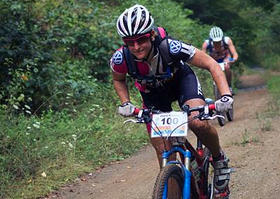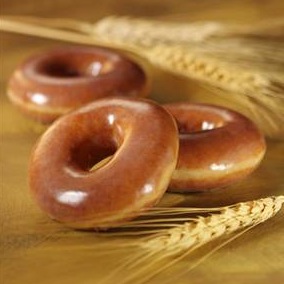
This study investigated effects of a high protein (PROT) versus a high carbohydrate (CHO) diet on performance and physiological responses during an ultraendurance climbing race at moderate altitude. On two different periods, in a randomised crossover design, ten climbers (30.0+/-0.9 years) participated in the race (duration 29 h approximately, energy expenditure 43.6+/-1.2 MJ.day (-1)) and were fed either with the PROT (30% protein content) or the CHO diet (68% carbohydrate) each providing 16.74 MJ. Mental performance was assessed by the Stroop test and we estimated maximal voluntary strength of quadriceps muscle. We quantified metabolic and hormonal circulating concentrations. Mental performance was unaffected after the two races, while muscular performance and body weight were decreased (both p<0.01) with no diet effects. Decreases were measured for IGF-I concentration and its binding protein IGFBP-3 (p<0.001), and increases for cortisol and norepinephrine (p<0.01) with no diet effects. Glucose concentration decreased (p<0.05) without diet effects, while amino acids (leucine, isoleucine, valine, and tyrosine) decreased in CHO group (p<0.001). Leptin concentration decreased (p<0.001) without diet effects, whereas total ghrelin increased in CHO group (p<0.01). Our results showed that a high PROT or high CHO intake during physical exertion at moderate altitude maintained mental performance, but did not limit muscle force reduction and body weight loss. There was decreased glucose availability, and hormonal responses indicated both catabolism and extreme energy deficiency induced by exercise with opposite responses of ghrelin and leptin. The ghrelin response was additionally indicative of macronutrient intake during the race.
Reference
Horm Metab Res. 2010 Jan;42(1):31-7. Epub 2009 Oct 9.
Influence of protein- versus carbohydrate-enriched feedings on physiological responses during an ultraendurance climbing race.
Bourrilhon C, Lepers R, Philippe M, Beers PV, Chennaoui M, Drogou C, Beauvieux MC, Burnat P, Guezennec CY, Gomez-Merino D.
Department of Physiology, IMASSA, 91223 Brétigny-sur-Orge, France. cbourrilhon@imassa.fr


 This effect may be due to differences in the fundamental amino acid composition of the protein (i.e., its amino acid score) and its rate of digestion. Milk proteins, specifically casein and whey, are the highest quality proteins and are quite different in terms of their rates of digestion and absorption. New data suggest that whey protein is better able to support MPS than is soy protein, a finding that may explain the greater ability of whey protein to support greater net muscle mass gains with resistance exercise. This review focuses on evidence showing the differences in responses of MPS, and ultimately muscle protein accretion, to consumption of milk- and soy-based supplemental protein sources in humans.
This effect may be due to differences in the fundamental amino acid composition of the protein (i.e., its amino acid score) and its rate of digestion. Milk proteins, specifically casein and whey, are the highest quality proteins and are quite different in terms of their rates of digestion and absorption. New data suggest that whey protein is better able to support MPS than is soy protein, a finding that may explain the greater ability of whey protein to support greater net muscle mass gains with resistance exercise. This review focuses on evidence showing the differences in responses of MPS, and ultimately muscle protein accretion, to consumption of milk- and soy-based supplemental protein sources in humans. Further adjustment for socio-economic status, alcohol consumption, smoking, maximal oxygen uptake, BMI and the energy-adjusted daily intakes of folate and PUFA did not attenuate this association (relative risk (RR) = 0.23, 95 % CI 0.06, 0.83). No associations were observed between depression and intake of tea (drinkers v. non-drinkers; RR = 1.19, 95 % CI 0.54, 2.23) or caffeine (highest quartile v. lowest quartile; RR = 0.99, 95 % CI 0.40, 2.45). CONCLUSIONS: Coffee consumption may decrease the risk of depression, whereas no association was found for tea and caffeine intake.
Further adjustment for socio-economic status, alcohol consumption, smoking, maximal oxygen uptake, BMI and the energy-adjusted daily intakes of folate and PUFA did not attenuate this association (relative risk (RR) = 0.23, 95 % CI 0.06, 0.83). No associations were observed between depression and intake of tea (drinkers v. non-drinkers; RR = 1.19, 95 % CI 0.54, 2.23) or caffeine (highest quartile v. lowest quartile; RR = 0.99, 95 % CI 0.40, 2.45). CONCLUSIONS: Coffee consumption may decrease the risk of depression, whereas no association was found for tea and caffeine intake. Although in vitro studies of organic fruits and vegetables consistently demonstrate that organic foods have greater antioxidant activity, are more potent suppressors of the mutagenic action of toxic compounds, and inhibit the proliferation of certain cancer cell lines, in vivo studies of antioxidant activity in humans have failed to demonstrate additional benefit. Clear health benefits from consuming organic dairy products have been demonstrated in regard to allergic dermatitis.
Although in vitro studies of organic fruits and vegetables consistently demonstrate that organic foods have greater antioxidant activity, are more potent suppressors of the mutagenic action of toxic compounds, and inhibit the proliferation of certain cancer cell lines, in vivo studies of antioxidant activity in humans have failed to demonstrate additional benefit. Clear health benefits from consuming organic dairy products have been demonstrated in regard to allergic dermatitis. Science Says: As meat is a rich source of the omega-3 fatty acid docosapentaenoic acid (DPA) and Australians consume six times more meat than fish, investigation of the potential health benefit of DPA is warranted. The aims were to compare the effects of seal oil supplementation with fish oil, on measures of plasma lipids and blood pressure in hypertriglyceridaemic subjects. Forty-eight volunteers were recruited from the Wollongong community and were randomly allocated to one of three groups either receiving 1 g/day of long-chain omega-3 polyunsaturated fatty acids (LC n-3 PUFA) using one of three oils: seal oil capsules (340 mg eicosapentaenoic acid (EPA), 230 mg DPA, 450 mg DHA), fish oil capsules (210 mg EPA, 30 mg DPA, 810 mg DHA) or placebo capsules (containing sunola oil) for 6 weeks. Plasma triglycerides remained unchanged in the placebo group, whilst reductions of 7 and 14% (P < 0.05) were seen in the fish oil and seal oil groups respectively. Systolic blood pressure improved by 8 and 5 mmHg with seal oil and fish oil respectively (P < 0.05). The mean arterial pressure was significantly lower after seal oil supplementation (P < 0.005) compared with the placebo group. These results indicate oil in lowering plasma triglycerides and blood pressure.
Science Says: As meat is a rich source of the omega-3 fatty acid docosapentaenoic acid (DPA) and Australians consume six times more meat than fish, investigation of the potential health benefit of DPA is warranted. The aims were to compare the effects of seal oil supplementation with fish oil, on measures of plasma lipids and blood pressure in hypertriglyceridaemic subjects. Forty-eight volunteers were recruited from the Wollongong community and were randomly allocated to one of three groups either receiving 1 g/day of long-chain omega-3 polyunsaturated fatty acids (LC n-3 PUFA) using one of three oils: seal oil capsules (340 mg eicosapentaenoic acid (EPA), 230 mg DPA, 450 mg DHA), fish oil capsules (210 mg EPA, 30 mg DPA, 810 mg DHA) or placebo capsules (containing sunola oil) for 6 weeks. Plasma triglycerides remained unchanged in the placebo group, whilst reductions of 7 and 14% (P < 0.05) were seen in the fish oil and seal oil groups respectively. Systolic blood pressure improved by 8 and 5 mmHg with seal oil and fish oil respectively (P < 0.05). The mean arterial pressure was significantly lower after seal oil supplementation (P < 0.005) compared with the placebo group. These results indicate oil in lowering plasma triglycerides and blood pressure.